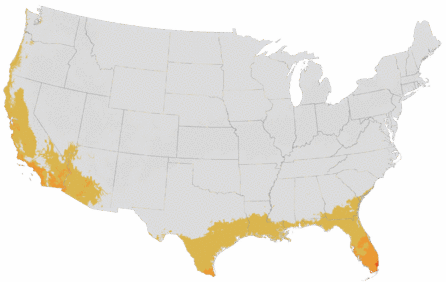You're growing in this Zip Code:
Change LocationDiscover Plants for Your Area
White Lightnin'® Trailing Lantana
Lantana sellowiana 'Monma'
Retailers Near You
No Retailers found within 100 miles of your zipcode
Be Inspired: How to Use this Plant
| Bloom Time | Spring and summer; longer in frost-free areas |
|---|---|
| Deciduous/Evergreen | Evergreen |
| Special Features | Attracts Hummingbirds, Easy Care, Waterwise, Benefits Birds |
| Problems/Solutions | Coastal Exposure, Deer Resistant, Erosion Control |
| Growth Rate | Moderate |
| Growth Habit | Spreading |
| Flower Attributes | Long Bloom Season, Repeat Flowering, Showy Flowers |
| Landscape Use | Border, Container, Ground Cover, Hillside |
| Design Ideas | Very resilient in extreme heat, particularly reflected heat off driveways or street paving. A natural for filling sunny banks and slopes. Plant in flower and shrub beds, raised planters, along fence lines and foundations, and in parkways. Put them in pots for powerful color on a deck or patio with brightly blooming annual flowers. |
| Flower Color | White |
| Foliage Color | Green |
| Companion Plants | Fountain Grass (Pennisetum); Heliotrope (Heliotrope); Yarrow (Achillea); Hibiscus (Hibiscus); Cordyline (Cordyline); Salvia (Salvia) |
| Care Instructions | Thrives in average, well-drained soils. Water deeply, regularly in first growing season to establish root system. Once established in the landscape, reduce frequency; continue to water container plants regularly. Space 3 to 5 ft. apart as groundcover. Fertilize in spring. Remove spent flowers for a tidy appearance. |
| Lore | Lantana sellowiana is also known as L. montevidensis, named because it is native to the hills surrounding Uruguay capital city of Montevideo. A member of the Verbenacea family, it is sometimes referred to as Wild Verbena. Lantana species have been cultivated for nearly 300 years, and lore tells us it has been used for centuries longer in folk medicines; poultices for snake bites and sprains, and elixirs to treat ailments. It is said that the dried leaves burned in a glass jar are a natural mosquito repellent. However, it must be noted that the leaves and stems contain an alkaloid that is toxic to browsing animals, and the berries are poisonous. The bright, aromatic flowers of Lantana are adored by nectar-seeking wildlife, and as such are a a staple of a classic butterfly garden. |
| Bloom Time | Spring and summer; longer in frost-free areas |
|---|---|
| Deciduous/Evergreen | Evergreen |
| Special Features | Attracts Hummingbirds, Easy Care, Waterwise, Benefits Birds |
| Problems/Solutions | Coastal Exposure, Deer Resistant, Erosion Control |
| Growth Rate | Moderate |
| Growth Habit | Spreading |
| Flower Attributes | Long Bloom Season, Repeat Flowering, Showy Flowers |
Retailers Near You
No Retailers found within 100 miles of your zipcode
Retailers Near You
No Retailers found within 100 miles of your zipcode
Buy Online
We cannot currently ship this product to your zip code.
About Us
We have been pioneers and craftsmen in the art of growing plants for nearly
100 years. Since our founding in Southern California by Harry E. Rosedale, Sr.
in 1926, we have been absolutely dedicated and obsessed with quality.
We have been pioneers and craftsmen in the art of growing plants for nearly 100 years. Since our founding in Southern California by Harry E. Rosedale, Sr. in 1926, we have been absolutely dedicated and obsessed with quality.






